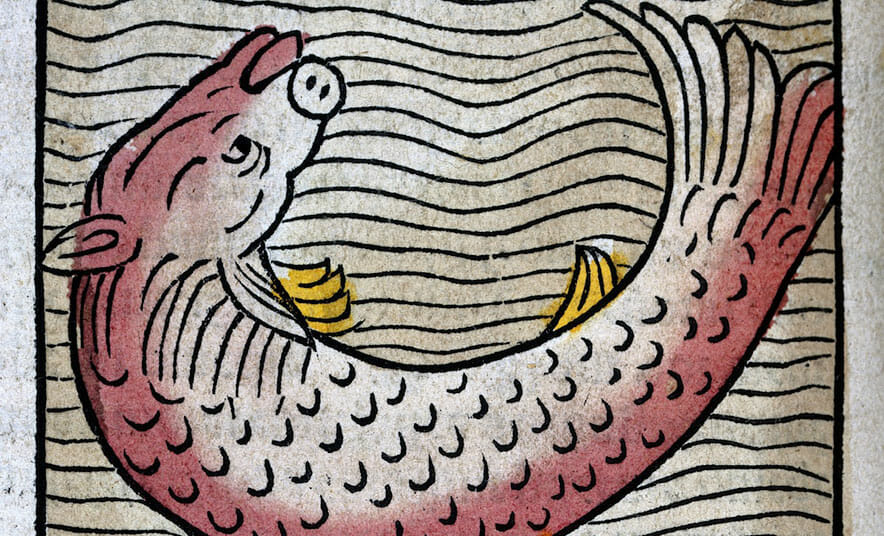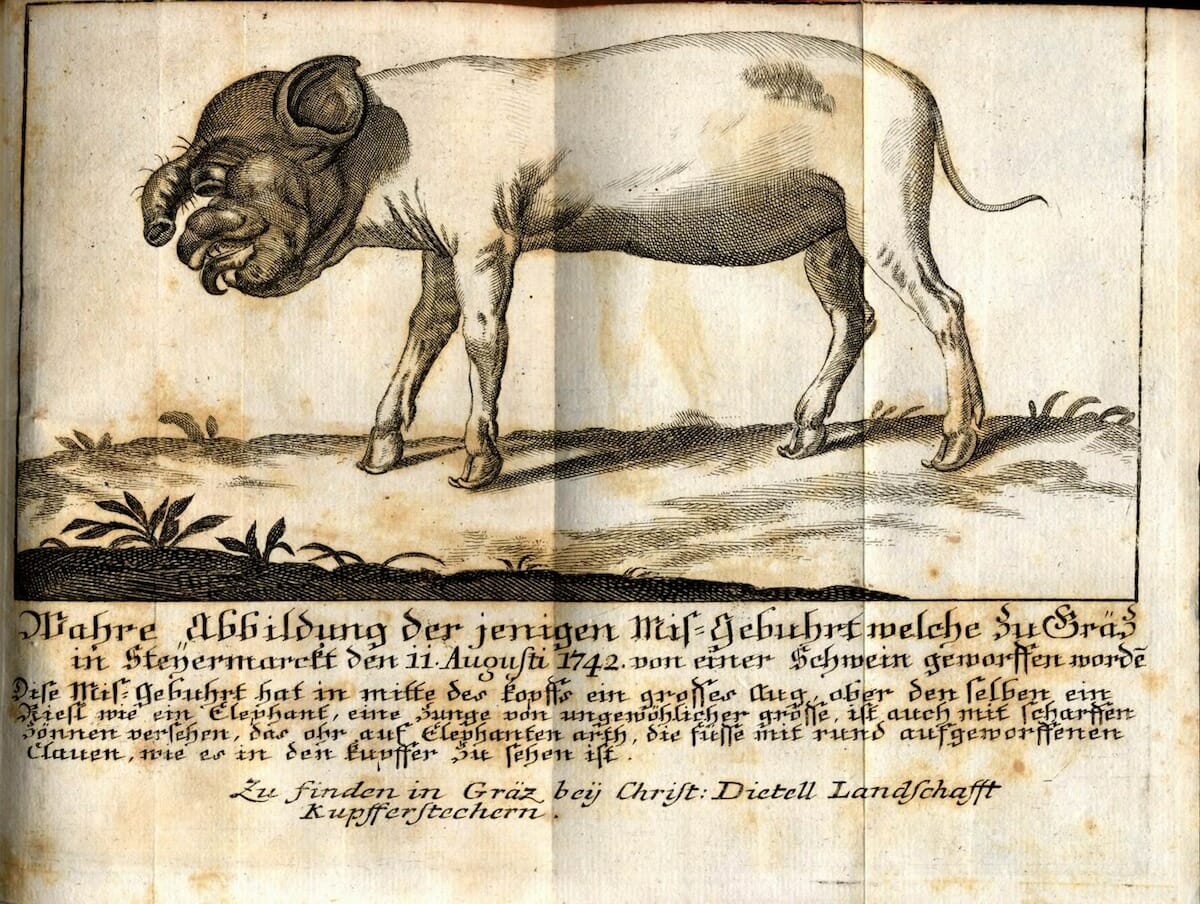Swine Flu: The Strange Medical and Magical History of Pigs
The winding and weird relationship between pigs and humans.
Swine Flu: The Strange Medical and Magical History of Pigs
The winding and weird relationship between pigs and humans.

Thankfully, the pictured pigfish (fishpig?) was not meant to be eaten. The colored woodprint was included in Ortus Sanitatis, a late 15th century German guide to the medicinal uses of plants and animals. Alongside seemingly innocuous woodcuts of onions and sheep, the author included whimsical images of pigfish, mermaids, winged cows, and human children sprouting like Thumbelina from nondescript green plants.
The pigfish wasn’t the only bizarre rendering of pigs in the olden days. The trend continued into the early modern era (roughly 1500 to 1800) as well. In England, pigs were the focus of witches’ spells that made them “leap and dance,” employed satirically to mock vain women and were used as guinea pigs (see what I did there?) to test vaccines.
Pigs were, especially, featured in single page broadsheets that documented “monstrous births.” These English broadsheets, especially plentiful in the 16th century, included cases of a pig so mutated that it lacked a snout and even a case of conjoined pigs. The English so demanded tales of these monstrous pigs that they even published the case of a Danish pig, imported to England, that had the ears of a lion, a wool covering like a sheep, and talon-like feet. The author seemed almost relieved to report that the pig ate “haye and grasse, as Breade and Apples, with such other thinges as sheep and Swyne do feede on.” At last, something recognizable about the creature!

Given the givens, it seems unlikely that anyone living in early modern England would want to eat pork, right? Yet, food scholars have noted time and time again that pork and pork products were a large part of medieval and early modern European diets. This was due to two reasons: As P.W. Hammond observed in his “Food and Feast in Medieval England,” pigs were easy to raise in both town and country. Joan Thirsk, in Food in Early Modern England, added that pigs had the added bonus of giving birth to large litters twice per year and yielding the most “bounteous supply of meat.” Thus, as early modern food historian Ken Albala has argued, pork was the most widely eaten meat across all class lines throughout Europe.
This might explain the obsessive nature with which early modern medical writers debated the health of pork products. Medicine, at the time, was largely based upon the theory of the four humours ”“ black bile, yellow bile, blood and phlegm. It was believed that all living things possessed these four humours in varying quantities and that health was dependent on the proper balance of each. Too much black bile, for example, and you would be melancholic. Too much yellow bile and you would be a grump! The humoural nature of food was key to one’s health.

Agreeing with Galen, the 2nd century Greek physician, most of these medical writers agreed that pork was, generally, a healthy meat. But this came with a lot of caveats. John Archer, a quack doctor who also served as physician to King Charles II, wrote that “swines flesh nourisheth very plentifully and yields firm nutriment.” Suckling pigs and boars were also deemed “nourishing” meats. The former, however, was not healthy for all people. Suckling pigs were considered to be a humid meat that, when consumed, allowed “fumous vapours” to ascend to the brain causing headaches and dizziness. Headcheese, as well, was considered to be incredibly unhealthy. As 16th century writer, William Bullein wrote, “pigges braines, and all slimie meates, bee euill for thee.”
Indeed. Slimy meats sound terrible.
In terms of the humours, pig’s flesh was considered a hot and moist meat, to be avoided by those of overly hot and moist humours. Medical minds thought superfluous blood and phlegm caused gout, historically the affliction of wealthy (and frequently obese) men. Pork, then, was to be avoided at all costs. In some cases, only specific types of pig’s flesh had to be avoided. A “cholerick” person, full of yellow bile, should not eat salted pork meats such as bacon, while a pork roast with currants or accompanied by “green sauce” ”“ a 17th century recipe suggests this was made with sorrel, eggs, vinegar, and butter ”“ was acceptable.
So when was pork actually good for you? Well, William Langham, a 16th century physician, agreed with Galen that pork was best eaten by healthy, active people. If not, pork ”“ specifically pig’s feet ”“ were especially good for the melancholic as it made the “veynes tender and moiste.”
Are you suffering from an overabundance of yellow or black bile? If so, I leave you with a 17th century recipe meant to balance out those humours:
[mf_blockquote layout=”left”]”Take… fresh Pig-pork… let them simper ten or twelve hours by a soft fire, in a sufficient quantity of Springwater, with Mary-golds, Rosemary, Time, Savory, Sweet-marjoram, Mace, or Cinamon: when ’tis almost boil’d enough, add to it a crust of bread, then strain it: To make it more nourishing, put to it, as you eat it, the yolk of an Egg and Sugar.”[/mf_blockquote]
(Photos courtesy of Wellcome Library, London.)
Follow us
This work is licensed under a Creative Commons Attribution-NoDerivatives 4.0 International License.
Want to republish a Modern Farmer story?
We are happy for Modern Farmer stories to be shared, and encourage you to republish our articles for your audience. When doing so, we ask that you follow these guidelines:
Please credit us and our writers
For the author byline, please use “Author Name, Modern Farmer.” At the top of our stories, if on the web, please include this text and link: “This story was originally published by Modern Farmer.”
Please make sure to include a link back to either our home page or the article URL.
At the bottom of the story, please include the following text:
“Modern Farmer is a nonprofit initiative dedicated to raising awareness and catalyzing action at the intersection of food, agriculture, and society. Read more at <link>Modern Farmer</link>.”
Use our widget
We’d like to be able to track our stories, so we ask that if you republish our content, you do so using our widget (located on the left hand side of the article). The HTML code has a built-in tracker that tells us the data and domain where the story was published, as well as view counts.
Check the image requirements
It’s your responsibility to confirm you're licensed to republish images in our articles. Some images, such as those from commercial providers, don't allow their images to be republished without permission or payment. Copyright terms are generally listed in the image caption and attribution. You are welcome to omit our images or substitute with your own. Charts and interactive graphics follow the same rules.
Don’t change too much. Or, ask us first.
Articles must be republished in their entirety. It’s okay to change references to time (“today” to “yesterday”) or location (“Iowa City, IA” to “here”). But please keep everything else the same.
If you feel strongly that a more material edit needs to be made, get in touch with us at [email protected]. We’re happy to discuss it with the original author, but we must have prior approval for changes before publication.
Special cases
Extracts. You may run the first few lines or paragraphs of the article and then say: “Read the full article at Modern Farmer” with a link back to the original article.
Quotes. You may quote authors provided you include a link back to the article URL.
Translations. These require writer approval. To inquire about translation of a Modern Farmer article, contact us at [email protected]
Signed consent / copyright release forms. These are not required, provided you are following these guidelines.
Print. Articles can be republished in print under these same rules, with the exception that you do not need to include the links.
Tag us
When sharing the story on social media, please tag us using the following: - Twitter (@ModFarm) - Facebook (@ModernFarmerMedia) - Instagram (@modfarm)
Use our content respectfully
Modern Farmer is a nonprofit and as such we share our content for free and in good faith in order to reach new audiences. Respectfully,
No selling ads against our stories. It’s okay to put our stories on pages with ads.
Don’t republish our material wholesale, or automatically; you need to select stories to be republished individually.
You have no rights to sell, license, syndicate, or otherwise represent yourself as the authorized owner of our material to any third parties. This means that you cannot actively publish or submit our work for syndication to third party platforms or apps like Apple News or Google News. We understand that publishers cannot fully control when certain third parties automatically summarize or crawl content from publishers’ own sites.
Keep in touch
We want to hear from you if you love Modern Farmer content, have a collaboration idea, or anything else to share. As a nonprofit outlet, we work in service of our community and are always open to comments, feedback, and ideas. Contact us at [email protected].by Samantha Sandassie, Modern Farmer
March 12, 2014
Modern Farmer Weekly
Solutions Hub
Innovations, ideas and inspiration. Actionable solutions for a resilient food system.
ExploreExplore other topics
Share With Us
We want to hear from Modern Farmer readers who have thoughtful commentary, actionable solutions, or helpful ideas to share.
SubmitNecessary cookies are absolutely essential for the website to function properly. This category only includes cookies that ensures basic functionalities and security features of the website. These cookies do not store any personal information.
Any cookies that may not be particularly necessary for the website to function and are used specifically to collect user personal data via analytics, ads, other embedded contents are termed as non-necessary cookies.